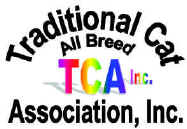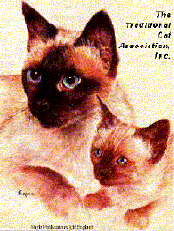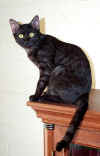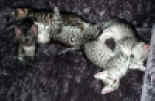
 The
Traditional Cat Association,
Inc.©1987®TM
Official Website
The
Traditional Cat Association,
Inc.©1987®TM
Official Website
Founded 1987, by Diana L.
Fineran
|
" Home of the Traditional Cat"© |
|
Our Motto: To Preserve,
Protect, Perpetuate, and Promote Traditional Cats.© |
|
|
||||||||||||
|
|
History of EGYPTIAN MAU
Lisa RootCopyright July 19.
2003 History of an Ancient Beauty,
The Egyptian Mau dates back over 3000 years. The Egyptian
Mau is perhaps the oldest of all domestic cats and one of only two naturally
spotted breeds still in existence (the other being the Bahraini Dilmun Cat). The
Mau is most likely the descendant of the African Wild Cat (Felis lyica ocreata.)
The domestication of the Mau occurred sometime between 4000 and 2000 BC. Egyptians very quickly saw the value of the Mau. They used
them initially to hunt and retrieve birds. It is very common to see pictures of
cats in marshes with birds in their mouths. The oldest images of cats in ancient
Egypt are hieroglyphs carved on a temple wall found to the south of Cairo dated
around 2200 BC. Around 2000 BC and on, the Mau started to hold a great importance in religion and was worshiped as a god. The Mau represented almost every aspect of their life. They were represented by over twenty some gods and goddess that were catlike figures. Many cat cults, like the cult of Bastet, appeared during
this time. They continued in to the Roman occupation around 330 AD. When a cat died in Egypt the body was mummified and entombed. The family of the deceased cat shaved their Eye brows as a sign of mourning. If a cat was ever harmed during this time it was an offense punishable by death.
Modern GodsDuring World War lithe Mau faced extinction. The Mau was
soon saved by the exiled Russian princess, Nathalie Troubetskoy. The efforts of
the Princess brought the Mau back from the edge of extinction. One day, while she was staying in Italy, a young boy gave
her a silver spotted female kitten that he had been keeping in a shoe box. The
kitten had been given to the boy by a diplomat working in the Middle East.
Troubetskoy strived to learn more about the kitten. Her research lead her to
conclude that the kitten was an Egyptian Mau. Troubetskoy became determined to
save the Mau. She rescued some of the remaining Maus, and using her
political connections, she obtained several more through the Syrian embassy. Her
first Maus were Gregorio, a black male, and Lulu, a silver female, and Geppa, a
smoke male. In 1956, Troubetskoy and three Maus a silver female Fatima Baba, a
bronze male Fatima Jojo, and the third was apparently never bred, immigrated to
the United States. Once there, Troubetskoy established her Fatima Cattery and
promoted the breed. Many modern Maus can trace their ancestry back to
Troubetskoy’s cats. It is thought that Troubetskoy used outside cats as a
source of out crossing to begin with during this period, although not
documented, to insure the health of the breed. Only three colors of Mau are in
early pedigrees, Silver, Bronze and Smoke. Although there had to be blacks
during this period because of the Smoke, none were ever recorded until some
years later. There is some evidence that blues also occurred during this time,
but like the black the blue wasn’t accepted for registration until recently in
some associations so it makes it harder to track how far back or when they
appeared. Some attribute the dilute and possibly the recessive classic tabby
pattern gene to the out crosses used early on. In the 1970s mans began to suffer again from the limited
gene pool. Something had to be done. In 1980. Jean S. Mill, (Millwood cattery,
currently a Bengal breeder) was contacted by a zoo in New Delhi, India. There
was a cat running loose in the rhino pen that had gotten its tail mostly
severed. She saved the cat (Millwood Toby in CVA and Millwood Tory of Delhi) a
bronze male, along with another
bronze female (Millwood Tashi) and created the “Indian lines”. These cats
introduced the glitter gene, improved the health, improved the clarity and
contrast of spotting and produced a richer rufousing in the bronze. This opened
the registries for imports to he accepted. In the 1980s. Cathie Rowan (Rocat ) succeeded in bringing
thirteen mans into America, paving the way for more imports. In the early
1090’s, J. Len Davidson (Grandtrill) brought in four more Maus from Egypt.
These cats were Grandtrill Giza, Grandtrill Wafaya, Grandtrill Hosny, and
GrandtrillAlexandria, all bronze. These cats produced the “Egyptian” Lines.
These lines are larger than the other two lines. They produce much bigger litters, are extremely intelligent
and have greatly increased the gene pool. The most recent import was Fondcombe’s Sahourê. He was
imported from Egypt to France by Marie-Christine Hallepee in 1999. The imports we see today in the Egyptian Mau are taken
directly off the streets of Egypt and India. So their heritage remains unknown.
They are essential to the breed to maintain the Mau’s health, vitality, and
longevity. Had it not been for the efforts of the heroines who strived to save
the dying breed, the Egyptian Mau would most likely be lost to us forever. |
|
The Traditional Cat Association, Inc.©1987®TM ALL RIGHTS RESERVED © by John & Diana Fineran - Aug 1999- 2025 No portion of this website or any information contained within it may be copied, or in any way distributed, without the expressed written permission of John or Diana Fineran - No exceptions. |







